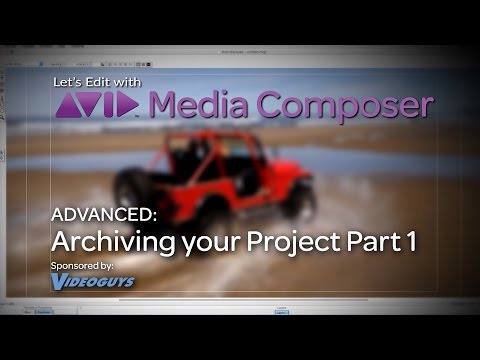
Let’s Edit with Media Composer – ADVANCED – Multi-channel Audio Exports
In this lesson, Kevin P McAuliffe talks about Multi-channel audio exports from Media Composer, and how DNxHD doesn’t always need to be your export codec of choice!

In this lesson, Kevin P McAuliffe talks about Multi-channel audio exports from Media Composer, and how DNxHD doesn’t always need to be your export codec of choice!

In this lesson, Kevin P McAuliffe talks about your Import settings, and focuses in on a very important aspect of importing, and that is supported codecs inside of Media Composer. If you don’t set up your imports correctly, you’ll end up recompressing your footage, instead of re-wrapping it.

In this lesson, Kevin P McAuliffe talks about your Grid settings, but more importantly, he talks about a concept that, if you’re delivering your content to a TV station or network, you will need to know, and that is 4×3 safe inside of your 16×9 project.

In this lesson, in our final look at archiving in Avid Media Composer, Kevin P McAuliffe talks about another third party utility to consider when you’re looking for an archiving utility, and that is Automatic Duck Media Copy. This simple to use, yet very powerful app will have you archiving your media composer timelines in

In this lesson, Kevin P McAuliffe talks about a third party utility to archive your projects called Media Mover. Whether you want to archive your entire sequence (all media), or everything in your project (Media, Precomputes, etc), Media Mover will make your life super simple with its easy to use interface, and it’s lightning fast

In this lesson, Kevin P McAuliffe talks about how to archive your project in Avid Media Composer. There are Third Party utilities on the market, but if you’re on a budget, you can successfully back up a sequence to an external hard drive on your own, with this straightforward tutorial!

In this lesson, Kevin P McAuliffe finishes his in-depth look at Transcoding by talking about working with larger than HD material. There are so many factors to keep in mind such as Source Settings, Proxy Timelines and Timeline Quality. This lesson will make sure you’re transcoding your larger than HD footage correctly every time!

In this lesson, Kevin P McAuliffe continues the discussion on Transcoding in Avid Media Composer, and talks about two different methods you might use to transcode your original camera media, into native MXF files.

In this week’s lesson, Kevin P McAuliffe looks at the process of Transcoding. The first lesson in Transcoding focuses on the Linked to clips in your bins, and shows you how many “under the hood” features need to be considered and adjusted, before you can do the actual transcoding.

In this lesson, Kevin P McAuliffe talks about the most asked question he receives. What is the difference between Transcoding and Consolidating? Consolidating is up first, and Kevin gives you three examples of where you’re going to use Consolidating in your Media Composer workflows.

In this lesson, we take a look at some of the new features inside of Media Composer 8.4 including true Resolution Independence, Timeline Search, and AAX Audio Presets.

In the last lesson in our look at editing Music Video, we talk about how to stylize your footage, without having to go to Adobe’s After Effects. Using some simple color correction, Animatte, and a couple of BCC Lite effects that, if you’re on the Media Composer Subscription plan, you get for free, you can

In this lesson, Kevin P McAuliffe continues his look at editing Music videos by starting to talk about effects work in your music video timeline. Transitions play a big part in the editorial process, and sometimes you need to use a program like AE to create transitions, or buy them from a third-party company. In

In this lesson, Kevin P McAuliffe goes back to Basics with learning Multicamera editing, and talks about the ins and outs you’ll need to know to get up and editing with this technique quickly and easily. He looks at syncing your footage via Timecode or In points, and then dives into showing you how to

In this lesson, Kevin P McAuliffe continues his look at editing Music videos by talking about syncing up your footage to prep it for Multicamera editing inside of Media Composer. We take a look at Pluraleyes, a third party utility designed specifically for syncronizing non-timecoded clips, and the advantages and disadvantages of using this workflow.

Hi, I’m the guy updating this site. I hope you enjoy it, and that it’s useful for you. I don’t make the videos here, but I do collect them and add it here, so you can find them.
If you enjoy this page, and you absolutely want to give something back for my work of collecting these, then here is my paypal.